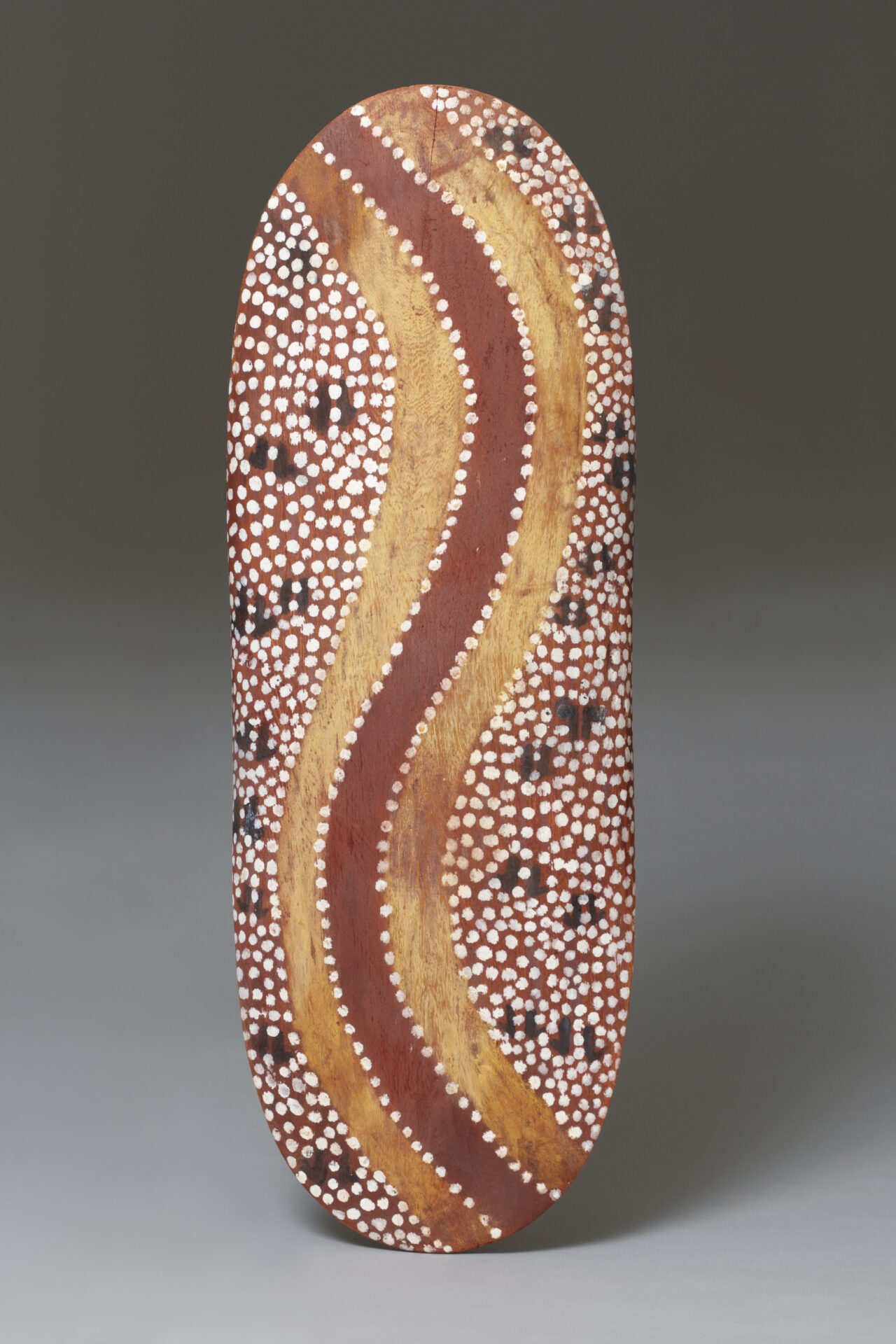
Article by Nicolas Peterson
Emeritus Professor of Anthropology, ANU
In the Tanami desert, Warlpiri and Anmatjerre men make softwood shields from the bean tree (Erythrina vespertilio), yinindi in Warlpiri, which had three main uses: protection when fighting; as a way to light fires using the friction method; and to paint designs on for ceremony usually indicating the country of the dancer holding the shield. This shield painted by Jimidja Jungarrayi, an important figure at the Warlpiri community of Yuendumu from the 1950-1980s, relates to a key ancestral figure for him, the mala, or rufous hare-wallaby (Largochestes hirsutus). This ancestral being emerged from the subterranean ancestral world at Mawurrungu, a place of many rock holes near Mt Cockburn 400km northwest of Alice Springs. He travelled north with a large group of people across the spinifex plains to Kapuka then to Yurnmadji, a long-lasting water in the Treuer Range, continuing north to Jila Well in the spinifex of the Tanami. Jimija’s interest in this ancestor’s travels relates to their northern portion. In the Dreaming the ancestral being was involved in a dispute settling ceremony, Ngajagula, at at Kapuka in which men and women of the N/Japaljarri -N/Jungarrayi and N/Japanangka-N/Japangardi subsections are attacked at the climax of the ceremony with fire brands by men of the Jampjinpa and Jupurrurla, and Jakamarra and Jangala subsections in a settling up. The last time this ceremony was held was in 1972. Over several weeks, each evening men and women would gather on the ceremonial ground at the edge of the camp and sing and dance for one to two hours while the sun set, leading up to the two final days. The songs followed the travels of the ancestor and his companions. They describe the travellers feeling tired and sorry for themselves because of the long journey, their hearts pumping at the effort, and the fathers’ teaching their sons how to use the boomerangs as accompaniment to their singing. One song describes how the ancestors as mala, but at the same time as humans, leave behind a well-defined track because of their long tails. It may be that the design on the shield represents this track although this is only a surmise.
The last wild populations of mala went extinct in the Tanami desert in the 1990s due to a combination of feral cats and foxes, and destructive wildfires. In late 2017 the remnants of a wild population were moved from Watarrka National Park (King’s Canyon area) and brought to Newhaven Wildlife Sanctuary, close to Mawurrungu and on Warlpiri country, to a 9,450 hectare, predator free enclosure. Warlpiri wildlife rangers are working closely with the Wildlife Sanctuary in this project. The second shield shows the yurrampi, honey ant dreaming. It is the ancestral being that created the soakage where the present-day community of Yuendumu is located on Anmatjerre land, even though the great majority of the people in the community are Warlpiri speakers. The proper name for this soakage, is Yakurrkaji which should, therefore, be the name of the community. Confusingly, Yuendumu (Yuntumu) is actually the name of a soakage in the hills to the south of the community and a different ancestral being altogether. The most important honey ant site is on Mont Allen station, known to them as Wurriwurri, and owned by Anmatjerre people.

Jack Butcher Japanaka
Yarrampi Shield (Honey Ant)
Wood, paint, 66.0 x 20.5 cm
Provenance: Presented to the SoAA by Gough Whitlam in 1980
SoAA Art and Object Collection
SoAA 2021.00077







